High-flow nasal cannula therapy for infants with bronchiolitis
- PMID: 38506440
- PMCID: PMC10953464
- DOI: 10.1002/14651858.CD009609.pub3
High-flow nasal cannula therapy for infants with bronchiolitis
Abstract
Background: Bronchiolitis is a common lower respiratory tract illness, usually of viral aetiology, affecting infants younger than 24 months of age and is the most common cause of hospitalisation of infants. It causes airway inflammation, mucus production and mucous plugging, resulting in airway obstruction. Effective pharmacotherapy is lacking and bronchiolitis is a major cause of morbidity and mortality. Conventional treatment consists of supportive therapy in the form of fluids, supplemental oxygen, and respiratory support. Traditionally, oxygen delivery is as a dry gas at 100% concentration via low-flow nasal prongs. However, the use of heated, humidified, high-flow nasal cannula (HFNC) therapy enables delivery of higher inspired gas flows of an air/oxygen blend, at 2 to 3 L/kg per minute up to 60 L/min in children. It can provide some level of continuous positive airway pressure (CPAP) to improve ventilation in a minimally invasive manner. This may reduce the need for invasive respiratory support, thus potentially lowering costs, with clinical advantages and fewer adverse effects.
Objectives: To assess the effects of HFNC therapy compared with conventional respiratory support in the treatment of infants with bronchiolitis.
Search methods: We searched CENTRAL, MEDLINE, Embase, CINAHL, LILACS, and Web of Science (from June 2013 to December 2022). In addition, we consulted ongoing trial registers and experts in the field to identify ongoing studies, checked reference lists of relevant articles, and searched for conference abstracts. Date restrictions were imposed such that we only searched for studies published after the original version of this review.
Selection criteria: We included randomised controlled trials (RCTs) or quasi-RCTs that assessed the effects of HFNC (delivering oxygen or oxygen/room air blend at flow rates greater than 4 L/minute) compared to conventional treatment in infants (< 24 months) with a clinical diagnosis of bronchiolitis.
Data collection and analysis: Two review authors independently used a standard template to assess trials for inclusion and extract data on study characteristics, risk of bias elements, and outcomes. We contacted trial authors to request missing data. Outcome measures included the need for invasive respiratory support and time until discharge, clinical severity measures, oxygen saturation, duration of oxygen therapy, and adverse events.
Main results: In this update we included 15 new RCTs (2794 participants), bringing the total number of RCTs to 16 (2813 participants). Of the 16 studies, 11 compared high-flow to low-flow, and five compared high-flow to CPAP. These studies included infants less than 24 months of age as stated in our selection criteria. There were no significant differences in sex. We found that when comparing high-flow to low-flow oxygen therapy for infants with bronchiolitis there may be a reduction in the total length of hospital stay (mean difference (MD) -0.65 days, 95% confidence interval (CI) -1.23 to -0.06; P < 0.00001, I2 = 89%; 7 studies, 1951 participants; low-certainty evidence). There may also be a reduction in the duration of oxygen therapy (MD -0.59 days, 95% CI -1 to -0.18; P < 0.00001, I2 = 86%; 7 studies, 2132 participants; low-certainty evidence). We also found that there was probably an improvement in respiratory rate at one and 24 hours, and heart rate at one, four to six, and 24 hours in those receiving high-flow oxygen therapy when compared to pre-intervention baselines. There was also probably a reduced risk of treatment escalation in those receiving high-flow when compared to low-flow oxygen therapy (risk ratio (RR) 0.55, 95% CI 0.39 to 0.79; P = 0.001, I2 = 43%; 8 studies, 2215 participants; moderate-certainty evidence). We found no difference in the incidence of adverse events (RR 1.2, 95% CI 0.38 to 3.74; P = 0.76, I2 = 26%; 4 studies, 1789 participants; low-certainty evidence) between the two groups. The lack of comparable outcomes in studies comparing high-flow and CPAP, as well as the small numbers of participants, limited our ability to perform meta-analysis on this group.
Authors' conclusions: High-flow nasal cannula therapy may have some benefits over low-flow oxygen for infants with bronchiolitis in terms of a greater improvement in respiratory and heart rates, as well as a modest reduction in the length of hospital stay and duration of oxygen therapy, with a reduced incidence of treatment escalation. There does not appear to be a difference in the number of adverse events. Further studies comparing high-flow nasal cannula therapy and CPAP are required to demonstrate the efficacy of one modality over the other. A standardised clinical definition of bronchiolitis, as well as the use of a validated clinical severity score, would allow for greater and more accurate comparison between studies.
Copyright © 2024 The Cochrane Collaboration. Published by John Wiley & Sons, Ltd.
Conflict of interest statement
Michael Armarego has declared that they have no conflict of interest. Hannah Forde has declared that they have no conflict of interest. Karen Wills has declared that they have no conflict of interest. Sean Beggs has declared that they have no conflict of interest.
Figures
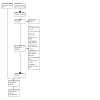
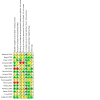
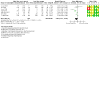
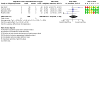

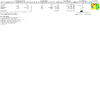

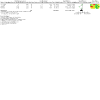

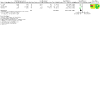
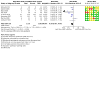

Update of
-
High-flow nasal cannula therapy for infants with bronchiolitis.Cochrane Database Syst Rev. 2014 Jan 20;2014(1):CD009609. doi: 10.1002/14651858.CD009609.pub2. Cochrane Database Syst Rev. 2014. Update in: Cochrane Database Syst Rev. 2024 Mar 20;3:CD009609. doi: 10.1002/14651858.CD009609.pub3. PMID: 24442856 Free PMC article. Updated.
References
References to studies included in this review
Abboud 2015 {published data only}
-
- Abboud P, Roth P, Yacoub N, Stolfi A. Efficacy of high flow/high humidity nasal cannula therapy in viral bronchiolitis. Critical Care Medicine 2015;43(12 Suppl 1):177.
Borgi 2021 {published data only}
-
- Borgi A, Louati A, Ghali N, Hajji A, Ayari A, Bouziri A, et al. High flow nasal cannula therapy versus continuous positive airway pressure and nasal positive pressure ventilation in infants with severe bronchiolitis: a randomized controlled trial. Pan-African Medical Journal 2021;40:133. [DOI: 10.11604/pamj.2021.40.133.30350] - DOI - PMC - PubMed
Cesar 2020 {published data only}
-
- Cesar R, Bispo B, Felix PH, Modolo MC, Cabo S, Souza A, et al. A randomized controlled trial of high-flow nasal cannula versus cpap in critical bronchiolitis. Critical Care Medicine 2018;46(Suppl 1):553. [DOI: 10.1097/01.ccm.0000529144.79628.12] - DOI
Durand 2020 {published data only}
-
- Durand P. High-flow nasal canula (HFNC) in infant hospitalized with moderate bronchiolitis-results of a multicenter open-label RCT in pediatric health care (bronchopti study). Annals of Intensive Care 2019;9(Suppl 1):17. [DOI: 10.1186/s13613-018-0474-7] - DOI
Ergul 2018 {published data only}
-
- Ergul AB, Caliskan E, Samsa H, Gokcek I, Kaya A, Zararsiz GE, et al. Using a high-flow nasal cannula provides superior results to OxyMask delivery in moderate to severe bronchiolitis: a randomized controlled study. European Journal of Pediatrics 2018;177(8):1299-307. [DOI: 10.1007/s00431-018-3191-1] - DOI - PubMed
Eşki 2022 {published data only}
-
- Eşki A, Özturk GK, Turan C, Gulen F, Demir E. Comparision of high flow nasal cannula and standard face mask oxygen treatment in children with acute moderate and severe bronchiolitis. Turkish Thoracic Journal 2019;20(Suppl 1):S53.
Franklin 2018 {published data only}
-
- Franklin D, Dalziel S, Schlapbach LJ, Babl F, Oakley E, Craig SS, et al. Early high flow nasal cannula therapy in bronchiolitis, a prospective randomised control trial (protocol): a Paediatric Acute Respiratory Intervention Study (PARIS). BMC Pediatrics 2015;15(1):183. [DOI: 10.1186/s12887-015-0501-x] - DOI - PMC - PubMed
Hilliard 2012 {published data only}
-
- Archer N, Cottis H, Ball S, Mills K, Hilliard T. A pilot randomised controlled study of oxygen delivery via vapotherm in infants with moderately severe acute bronchiolitis [Abstract]. In: European Respiratory Society Annual Congress, Vienna, Austria, September 12-16 2009. 2009:P4002.
-
- Hilliard TN, Archer N, Laura H, Heraghty J, Cottis H, Mills K, et al. Pilot study of vapotherm oxygen delivery in moderately severe bronchiolitis. Archives of Disease in Childhood 2012;97:182-3. - PubMed
Kepreotes 2017 {published data only}
-
- Kepreotes E (Clinical Improvement Co-ordinator, John Hunter Children's Hospital, Newcastle, NSW, Australia). [personal email communication]. Letter to: Elizabeth Kepreotes Clinical Improvement Co-ordinator, John Hunter Children's Hospital July 2017.
-
- Kepreotes E, Whitehead B, Attia J, Oldmeadow C, Collison A, Goddard B, et al. A randomized controlled trial examining high-flow oxygen in the management of infants with moderate bronchiolitis. In: European Respiratory Journal. Conference: European Respiratory Society Annual Congress 2016. United Kingdom. 2016:48.
-
- Kepreotes E, Whitehead B, Attia J, Oldmeadow C, Collison A, Searles A, et al. High-flow warm humidified oxygen versus standard low-flow nasal cannula oxygen for moderate bronchiolitis (HFWHO RCT): an open, phase 4, randomised controlled trial. Lancet 2017;389(10072):930-9. [DOI: 10.1016/S0140-6736(17)30061-2] - DOI - PubMed
-
- Kepreotes E, Whitehead B, Lee M, Collison A, Goddard B, Cheese L. High-flow oxygen compared to standard nasal cannula oxygen does not reduce the median time on oxygen for infants with moderate bronchiolitis. Respirology (Carlton, Vic.) 2016;21(Suppl 2):52-63.
Kooiman 2017 {published and unpublished data}
-
- Kooiman LM. High flow oxygen in children with bronchiolitis: randomized, controlled research on oxygen application. Nederlands Tijdschrift voor Geneeskunde 2017;161(24):1474-502.
Milani 2016 {published data only}
Milesi 2017 {published data only}
-
- Milesi C, Essouri S, Pouyau R, Liet JM, Afanetti M, Baleine J, et al. Interest of high flow nasal cannula versus nasal continuous positive airway pressure during the management of severe bronchiolitis in infants: a multicenter randomized controlled trial. European Journal of Pediatrics. Conference: 6th Congress of the European Academy of Paediatric Societies. Switzerland. Conference start: 20161021. Conference end: 20161025 2016;175(11):1436.
-
- Milesi C, Ferragu F, Jacquot A, Pidoux O, Chautemp N, Mesnage R, et al. Randomized comparison between nasal continuous positive airway pressure (NCPAP) and conventional nasal oxygen delivery on respiratory muscle load and respiratory distress syndrome in young infants with severe acute bronchiolitis. Fundamental and Clinical Pharmacology 2010;24:106. 3075130]
-
- Milesi C, Ferragu F, Jacquot A, Pidoux O, Chautemps N, Mesnage R, et al. Randomized comparison between nasal continuous positive airway pressure (NCPAP) and conventional nasal oxygen delivery on respiratory muscle load and respiratory distress syndrome in young infants with severe acute bronchiolitis [Abstract]. American Journal of Respiratory and Critical Care Medicine 2010;181:A6057.
-
- Milesi C, Pierre AF, Deho A, Pouyau R, Liet JM, Guillot C, et al. A multicenter randomized controlled trial of a 3-L/kg/min versus 2-L/kg/min high-flow nasal cannula flow rate in young infants with severe viral bronchiolitis (TRAMONTANE 2). Intensive Care Medicine 2018;11:1870-8. - PubMed
-
- Milési C, Essouri S, Pouyau R, Liet J-M, Afanetti M, Portefaix A, et al. High flow nasal cannula (HFNC) versus nasal continuous positive airway pressure (nCPAP) for the initial respiratory management of acute viral bronchiolitis in young infants: a multicenter randomized controlled trial (TRAMONTANE study). Intensive Care Medicine 2017;43(2):209-16. [DOI: 10.1007/s00134-016-4617-8] - DOI - PubMed
Murphy 2020 {published and unpublished data}
Sarkar 2018 {published data only}
-
- Sarkar M, Sinha R, Roychowdhoury S, Mukhopadhyay S, Ghosh P, Dutta K, et al. Comparative study between noninvasive continuous positive airway pressure and hot humidified high-flow nasal cannulae as a mode of respiratory support in infants with acute bronchiolitis in pediatric intensive care unit of a tertiary care hospital. Indian Journal of Critical Care Medicine 2018;22(2):85-90. [DOI: 10.4103/ijccm.IJCCM_274_17] - DOI - PMC - PubMed
Ture 2020 {published data only}
-
- Ture E, Yazar A, Akn F, Pekcan S. High-flow nasal cannula is superior to standard face-mask oxygen therapy in viral bronchiolitis. Signa Vitae 2020;16(1):47-53. [DOI: 10.22514/sv.2020.16.0007] - DOI
Vahlkvist 2020 {published data only}
-
- Vahlkvist S, Jurgensen L, La Cour A, Markoew S, Petersen TH, Kofoed P-E. High flow nasal cannula and continuous positive airway pressure therapy in treatment of viral bronchiolitis: a randomized clinical trial. European Journal of Pediatrics 2020;179(3):513-8. 23308965 [DOI: 10.1007/s00431-019-03533-2] - DOI - PubMed
References to studies excluded from this review
Bajaj 2006 {published data only}
-
- Bajaj L, Bothner J, Turner C. A randomized trial of home oxygen therapy from the emergency department for acute bronchiolitis - In reply. Pediatrics 2006;118:1320-1. - PubMed
-
- Bajaj L, Turner CG, Bothner J. A randomized trial of home oxygen therapy from the emergency department for acute bronchiolitis. Pediatrics 2006;117:633-40. - PubMed
Balanzat 2006 {published data only}
-
- Balanzat AM, Lazarte G, Surarez V, Bonilla ME, Gighi M, Chede C, et al. Effects of different levels of nasal continuous positive airways pressure (CPAP) in infants with severe acute bronchiolitis [Abstract]. European Respiratory Journal 2006;28:264s [P1531].
Baudin 2017 {published data only}
-
- Baudin F, Pouyau R. High-flow nasal cannula in the pediatric ICU: popular or efficient? Respiratory Care 2017;62(8):1116-7. - PubMed
Blyth 2003 {published data only}
-
- Blyth TP, Kozlowska W, McKenzie SA, Carr SB. Randomised controlled trial of CPAP in severe bronchiolitis [abstract]. Thorax 2003;58:iii68.
Bueno Campaña 2014 {published data only}
-
- Bueno Campaña M, Olivares Ortiz J, Notario Muñoz C, Rupérez Lucas M, Fernández Rincón A, Patiño Hernández O, et al. High flow therapy versus hypertonic saline in bronchiolitis: randomised controlled trial. Archives of Disease in Childhood 2014;99(6):511-5. [DOI: 10.1136/archdischild-2013-305443] - DOI - PubMed
Chen 2019 {published data only}
-
- Chen DY, Zee ED, Gildengorin G, Fong EW. A pilot study of heated and humidified low flow oxygen therapy: an assessment in infants with mild and moderate bronchiolitis (HHOT AIR study). Pediatric Pulmonology 2019;54(5):620-7. - PubMed
Donlan 2011 {published data only}
-
- Donlan M, Fontela PS, Puligandla PS. Use of continuous positive airway pressure (CPAP) in acute viral bronchiolitis: a systematic review. Pediatric Pulmonology 2011;46:736-46. - PubMed
Figueruelo 2011 {published data only}
-
- Figueruelo AG, Villaescusa JU, Prieto MB, Garcia MJ, Bartolome SM, Cid JL. Use of high-flow nasal cannula for non-invasive ventilation in children. Anales De Pediatria 2011;75:182-7. - PubMed
Hathorn 2014 {published data only}
-
- Hathorn C, Ernst G, Hasan S, Wong D, Seear M. The hi-FLO study: a prospective open randomised controlled trial of high flow nasal cannula oxygen therapy against standard care in bronchiolitis. Thorax 2014;69(Suppl 2):A38.
Hough 2011 {published data only}
-
- Hough JL, Pham TM, Schibler A. Delivery of high flow nasal prong oxygen: the effect CPAP exposed. Pediatric Critical Care Medicine 2011;12:A7. - PubMed
Kefala 2015 {published data only}
-
- Kefala K, Nyamugabo K, Farhat N, Janssen A, Seghaye MC. High-flow nasal cannula heated-humidified (HFNC) oxygen (O2) at 2 litres (lt)/kg/min versus low-flow O2 (up to 2lt/min) in pediatric emergency department (PED) and pediatric ward (PW) in infants with bronchiolitis who need O2 administration: a combined prospective randomized controlled and retrospective study: preliminary results. European Respiratory Journal 2015;46(Suppl 59):Pa2173.
Kim 2011 {published data only}
-
- Kim IK, Phrampus E, Sikes K, Pendleton J, Saville A, Corcoran T, et al. Helium-oxygen therapy for infants with bronchiolitis: a randomized controlled trial. Archives of Pediatrics & Adolescent Medicine 2011;165:1115-22. - PubMed
Lal 2018 {published data only}
-
- Lal SN, Kaur J, Anthwal P, Goyal K, Bahl P, Puliyel JM. Nasal continuous positive airway pressure in bronchiolitis: a randomized controlled trial. Indian Pediatrics 2018;55(1):27-30. - PubMed
Martinón‐Torres 2002 {published data only}
-
- Martinón-Torres F, Rodríguez-Núñez A, Martinón-Sánchez JM. Heliox therapy in infants with acute bronchiolitis. Pediatrics 2002;109:68-73. - PubMed
Martinon‐Torres 2003 {published data only}
-
- Martinon-Torres F. Current treatment for acute viral bronchiolitis in infants. Expert Opinion on Pharmacotherapy 2003;4:1355-71. - PubMed
Martinon‐Torres 2008 {published data only}
-
- Martinon-Torres F, Rodriguez-Nunez A, Martinon-Sanchez JM. Nasal continuous positive airway pressure with heliox versus air oxygen in infants with acute bronchiolitis: a crossover study. Pediatrics 2008;121:e1190-5. - PubMed
Mayordomo‐Colunga 2018 {published data only}
McCullough 2017 {published data only}
-
- McCullough C. High-flow warm humidified oxygen versus standard low-flow nasal cannula for moderate bronchiolitis (HFWHO RCT): an open, phase 4, randomized controlled trial: Kepreotes E, Whitehead B, Attia J et al. Lancet 2017;389:930. Journal of Emergency Medicine 2017;53(1):157. [DOI: 10.1016/j.jemermed.2017.05.018] - DOI - PubMed
Milesi 2018 {published data only}
-
- Milesi C, Pierre AF, Deho A, Pouyau R, Liet JM, Guillot C, et al. A multicenter randomized controlled trial of a 3-L/kg/min versus 2-L/kg/min high-flow nasal cannula flow rate in young infants with severe viral bronchiolitis (TRAMONTANE 2). Intensive Care Medicine 2018;44(11):1870-8. - PubMed
Selvaraj 2022 {published data only}
-
- Selvaraj S, Muthu S, Chandramouli H, Periyasamy B. Efficacy of oxygen delivered through high flow nasal cannula versus non rebreathing mask in infants with mild and moderate bronchiolitis: an open-labelled randomised controlled trial. Journal of Clinical and Diagnostic Research 2022;16(7):1-4. [DOI: 10.7860/JCDR/2022/56450.16579] - DOI
Smith 1993 {published data only}
-
- Smith PG, el-Khatib MF, Carlo WA. PEEP does not improve pulmonary mechanics in infants with bronchiolitis. American Review of Respiratory Disease 1993;147:1295-8. - PubMed
Tie 2009 {published data only}
-
- Tie SW, Hall GL, Peter S, Vine J, Verheggen M, Pascoe EM, et al. Home oxygen for children with acute bronchiolitis. Archives of Disease in Childhood 2009;94:641-3. - PubMed
Unger 2008 {published data only}
-
- Unger S, Cunningham S. Effect of oxygen supplementation on length of stay for infants hospitalized with acute viral bronchiolitis. Pediatrics 2008;121:470-5. - PubMed
Additional references
AAPS 2006
-
- American Academy of Pediatrics Subcommittee on Diagnosis and Management of Bronchiolitis. Diagnosis and management of bronchiolitis. Pediatrics 2006;118(4):1774-93. - PubMed
Atkins 2004
Covidence [Computer program]
-
- Covidence. Melbourne, Australia: Veritas Health Innovation, 2023. Available at covidence.org.
Dafydd 2021
Dalziel 2022
De Klerk 2008
-
- De Klerk A. Humidified high-flow nasal cannula: is it the new and improved CPAP? Advances in Neonatal Care 2008;8(2):98-106. - PubMed
Deeks 2023
-
- Deeks JJ, Higgins JP, Altman DG (editors). Chapter 10: Analysing data and undertaking meta-analyses. In: Higgins JP, Thomas J, Chandler J, Cumpston M, Li T, Page MJ, Welch VA (editors). Cochrane Handbook for Systematic Reviews of Interventionsversion 6.4 (updated August 2023). Available from www.training.cochrane.org/handbook 2023.
Doucette 2016
-
- Doucette A, Jiang X, Fryzek J, Coalson J, McLaurin K, Ambrose CS. Trends in respiratory syncytial virus and bronchiolitis hospitalization rates in high-risk infants in a United States Nationally Representative Database, 1997-2012. PLOS One 2016;11(4):e0152208. [DOI: 10.1371/journal.pone.0152208] - DOI - PMC - PubMed
Dysart 2009
-
- Dysart K, Miller TL, Wolfson MR, Shaffer TH. Research in high flow therapy: mechanisms of action. Respiratory Medicine 2009;103(10):1400-5. - PubMed
Fernandes 2013
Gadomski 2010
GRADEpro GDT [Computer program]
-
- GRADEpro GDT. Version accessed 16 October 2023. Hamilton (ON): McMaster University (developed by Evidence Prime). Available at gradepro.org.
Hall 2009
Hartling 2011
Higgins 2011
-
- Higgins JPT, Green S (editors). Cochrane Handbook for Systematic Reviews of Interventions. Version 5.1.0 (updated March 2011). The Cochrane Collaboration, 2011. Available from training.cochrane.org/handbook/archive/v5.1/.
Higgins 2023
-
- Higgins JP, Thomas J, Chandler J, Cumpston M, Li T, Page MJ, Welch VA (editors). Cochrane Handbook for Systematic Reviews of Interventions version 6.4 (updated August 2023). Cochrane, 2023. Available from www.training.cochrane.org/handbook.
Kubicka 2008
-
- Kubicka ZJ, Limauro J, Darnall RA. Heated, humidified high-flow nasal cannula therapy: yet another way to deliver continuous positive airway pressure? Pediatrics 2008;121(1):82-8. - PubMed
Kusel 2006
-
- Kusel M, De Klerk N, Holt PG, Kebadze T, Johnston S, Sly P. Role of respiratory viruses in acute upper and lower respiratory tract illness in the first year of life: a birth cohort study. Pediatric Infectious Disease Journal 2006;25(8):680-6. - PubMed
Lampland 2009
-
- Lampland A, Plumm B, Meyers P, Worwa C, Mammel M. Observational study of humidified high-flow nasal cannula compared with nasal continuous positive airway pressure. Journal of Pediatrics 2009;154(2):177-82. - PubMed
Lee 2012
Lefebvre 2011
-
- Lefebvre C, Manheimer E, Glanville J. Chapter 6: Searching for studies. In: Higgins JP, Green S (editors). Cochrane Handbook for Systematic Reviews of Interventions. Version 5.1.0 (updated March 2011). The Cochrane Collaboration, 2011. Available from training.cochrane.org/handbook/archive/v5.1/.
Lin 2019
Manley 2016
-
- Manley BJ, Owen LS. High-flow nasal cannula: mechanisms, evidence and recommendations. Seminars in Fetal and Neonatal Medicine 2016;21(3):139-45. - PubMed
McKiernan 2010
-
- McKiernan C, Chua LC, Visintainer AF, Allen H. High flow nasal cannulae therapy in infants with bronchiolitis. Journal of Pediatrics 2010;156(4):634-8. - PubMed
Milesi 2013
-
- Milesi C, Baleine J, Matecki S, Durand S, Combes C, Rideau Batista Novais A, et al. Is treatment with a high flow nasal cannula effective in acute viral bronchiolitis? A physiologic study. Intensive Care Medicine 2013;39(6):1170. - PubMed
Pelletier 2006
-
- Pelletier AJ, Mansbach JM, Camargo CA Jr. Direct medical costs of bronchiolitis hospitalizations in the United States. Pediatrics 2006;118(6):2418-23. - PubMed
Piedra 2019
-
- Piedra P, Stark A. Patient education: bronchiolitis (and RSV) in infants and children (Beyond the Basics). UpToDate - Available from https://www.uptodate.com/contents/bronchiolitis-and-rsv-in-infants-and-c... 2019.
Ralston 2015
-
- Ralston SL, Lieverthal AS, Meissner HC, Alverson BK, Baley JE, Gadomski AM, et al. Clinical Practice Guideline: the diagnosis, management, and prevention of bronchiolitis. Pediatrics 2014 (amended 2015);136(4):782. - PubMed
RevMan Web 2024 [Computer program]
-
- RevMan Web. Version 7.5.0. The Cochrane Collaboration, 2024. Available at revman.cochrane.org.
Schibler 2011
-
- Schibler A, Pham T, Dunster K, Foster K, Barlow A, Gibbons K, et al. Reduced intubation rates for infants after introduction of high-flow nasal prong oxygen delivery. Intensive Care Medicine 2011;37(5):847-52. - PubMed
Shay 1999
-
- Shay DK, Holman RC, Newman RD, Liu LL, Stout JW, Anderson LJ. Bronchiolitis-associated hospitalizations among US children, 1980-1996. JAMA 1999;282(15):1440-6. - PubMed
Spence 2007
-
- Spence KL, Murphy D, Kilian C, McGonigle R, Kilani RA. High-flow nasal cannula as a device to provide continuous positive airway pressure in infants. Journal of Perinatology 2007;27(12):772. - PubMed
Spentzas 2009
-
- Spentzas T, Minarik M, Patters AB, Vinson B, Stidham G. Children with respiratory distress treated with high-flow nasal cannula. Journal of Intensive Care Medicine 2009;24(5):323-8. - PubMed
Spurling 2011
Vicencio 2010
-
- Vicencio AG. Susceptibility to bronchiolitis in infants. Current Opinion in Pediatrics 2010;22(3):302-6. - PubMed
References to other published versions of this review
Beggs 2012
Publication types
MeSH terms
LinkOut - more resources
Full Text Sources
Medical

